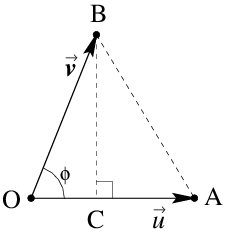Vectors: Distance, angle, dot product and cross product
 Dot product, angle and orthogonal projection
Dot product, angle and orthogonal projection
Dot product in 2D and 3D
We define the scalar product or dot product of vectors \(\vec{u}=\cv{u_1\\ u_2}\) and \(\vec{v}=\cv{v_1\\ v_2}\) in the coordinate plane \(\mathbb{R}^2\) as \[\vec{u}\boldsymbol{\cdot}\vec{v}=u_1\cdot v_1+u_2\cdot v_2 \]
We define the scalar product or standard dot product of v \(\vec{u}=\cv{u_1\\ u_2\\ u_3}\) and \(\vec{v}=\cv{v_1\\ v_2\\v_3}\) in the coordinate plane \(\mathbb{R}^3\) we define as \[\vec{u}\boldsymbol{\cdot}\vec{v}=u_1\cdot v_1+u_2\cdot v_2+ u_3\cdot v_3\]
Examples
\[\begin{aligned}\cv{2\\3}\boldsymbol{\cdot}\cv{4\\5}&=2\cdot 4+3\cdot 5\\ &=8+15=23\\ \\ \cv{2\\3}\boldsymbol{\cdot}\cv{3\\-2}&=2\cdot 3+3\cdot -2\\ &=6-6=0\\ \\ \cv{2\\3\\4}\boldsymbol{\cdot}\cv{5\\6\\-7}&=2\cdot 5+3\cdot 6+4\cdot -7=0\end{aligned}\]
This can be generalized to the \(n\)-dimensional coordinate space \(\mathbb{R}^n\).
The scalar (dot) product The scalar product or dot product of two vectors \(\vec{u}=\cv{u_1\\ \vdots \\ u_n}\) and \(\vec{v}=\cv{v_1\\ \vdots \\ v_n}\) in the \(n\)-dimensional space \(\mathbb{R}^n\), also referred to as the standard inner product, is defined as \[\vec{u}\boldsymbol{\cdot}\vec{v}=u_1\cdot v_1+u_2\cdot v_2 +\cdots+ u_n\cdot v_n=\sum_{i=1}^n u_i\cdot v_i\]
Note that for a vector \(\vec{v}\) in \(\mathbb{R}^n\) it we have \[\lVert v\rVert^2=\vec{v}\boldsymbol{\cdot} \vec{v}\]
Usually we just talk about the scalar product, dot product, or inner product if we mean the standard inner product and there is no possible confusion. The name dot product explains our choice of notation with a bold point. Other common formats that you may encounter in books and papers are \(\langle \vec{u},\vec{v}\rangle\) and \((\vec{u},\vec{v})\).
After all:\[\begin{aligned} \cv{0\\ 4}\boldsymbol{\cdot}\cv{7\\ 3} &= (0\cdot 7) + (4 \cdot 3) &\blue{\text{definition of dot product}} \\
&=12 &\blue{\text{final result}} \end{aligned}\]
Properties of the dot product the dot product on \(\mathbb{R}^n\) has the following properties for all scalars \(\alpha\) and \(\beta\), and for all vectors \(\vec{u}\), \(\vec{v}\) and \(\vec{w}\) :
- Symmetry: \(\vec{u}\boldsymbol{\cdot} \vec{v} = \vec{v}\boldsymbol{\cdot} \vec{u}\)
- Linearity: \(\left(\alpha\,\vec{u}+\beta\,\vec{v}\right)\boldsymbol{\cdot} \vec{w} = \alpha\,\vec{u}\boldsymbol{\cdot} \vec{w}+\beta\,\vec{v}\boldsymbol{\cdot} \vec{w}\)
- Standard: The inner product of a vector with itself is the square of the length, ie, \(\vec{v}\boldsymbol{\cdot} \vec{v}= \lVert\vec{v}\rVert^2\) for each vector \(\vec{v}\). The inner product is nonnegative and is equal to zero only if \(\vec{v}=\vec{0}\).
After all, using of the properties of the dot product we get \[\begin{aligned}\left(3\vec{u}\right)\boldsymbol{\cdot}\left( -3\vec{v}\right) &= 3\cdot -3 \cdot \left(\vec{u}\boldsymbol{\cdot}\vec{v}\right)\\ &=
-9\cdot\left(\vec{u}\boldsymbol{\cdot}\vec{v}\right)\\
&=-9\cdot 3\\
&=-27\\
\end{aligned}\]
Geometric meaning of the dot product The dot product in the plane \(\mathbb{R}^2\) and in the space \(\mathbb{R}^3\) has the following geometrical meaning:
The inner product \(\vec{u}\boldsymbol{\cdot}\vec{v}\) of two vectors \(\vec{u}\) and \(\vec{v}\) is equal to the product of the length of \(\vec{u}\) and the length of the projection of \(\vec{v}\) on the span of \(\vec{u}\).
In other words, the orthogonal projection of vector \(\vec{v}\) on the span of vector \(\vec{u}\) is equal to \(\left(\frac{\vec{u}\boldsymbol{\cdot}\vec{v}}{\vec{u}\boldsymbol{\cdot}\vec{u}}\right)\vec{u}\).
With reference to the figure below, we have the following formula: \[\vec{u}\boldsymbol{\cdot}\vec{v} = \lVert\vec{u}\rVert\cdot\lVert\vec{v}\rVert\cdot\cos(\phi)\tiny.\] 
Conversely, we can define an angle between two vectors via the dot product (or more generally via an inner product).
Angle between two vectors The (short) angle \(\phi\) between two nonzero vectors \(\vec{u}\) and \(\vec{v}\) is defined by the formula \[\cos(\phi) = \frac{\vec{u}\boldsymbol{\cdot}\vec{v}}{\lVert\vec{u}\rVert\cdot\lVert\vec{v}\rVert}\qquad (\text{with }0\le \phi\le \pi)\] This angle is acute if \(\vec{u}\boldsymbol{\cdot}\vec{v}>0\), and obtuse if \(\vec{u}\boldsymbol{\cdot}\vec{v}<0\).
We also notice that \(\vec{u}\boldsymbol{\cdot}\vec{v}=0\) means exactly that the vectors \(\vec{u}\) and \(\vec{v}\) are perpendicular to each other. We also say that the vectors \(\vec{u}\) and \(\vec{v}\) are orthogonal.
The following inequality is now evident in the plane \(\mathbb{R}^2\) and the space \(\mathbb{R}^3\) . This inequality, and herewith the concept of angle, generalizes to \(\mathbb{R}^n\).
Cauchy-Schwarz inequality Let \(\vec{u}\) and \(\vec{v}\) be vectors in \(\mathbb{R}^n\) then \[\left|\vec{u}\boldsymbol{\cdot}\vec{v}\right|\le \lVert\vec{u}\rVert\cdot\lVert\vec{v}\rVert\]
After all, if \(\phi\) is the angle between the vectors \(\vec{u}\) and \(\vec{v}\), then\[\begin{aligned}\vec{u}\boldsymbol{\cdot}\vec{v} &= \lVert\vec{u}\rVert\cdot\lvert\vec{v}\rvert\cdot \cos(\phi)\\ \\
&= 1 \cdot 4 \cdot\cos\left(90^{\circ}\right)\\ \\
&= 4 \cdot 0\\ \\
&= 0
\end{aligned}\]
Orthogonal projection on a plane Suppose that \(\mathcal{V}\) is a plane through the origin and spanned by two orthogonal direction vectors \(\vec{v}\) and \(\vec{w}\). Then you can compute the projection of \(\vec{u}\) on \(\mathcal{V}\) as linear combination of \(\vec{v}\) and \(\vec{w}\): \[\text{proj}_{\mathcal{V}}(\vec{u}) = \left(\frac{\vec{u}\boldsymbol{\cdot}\vec{v}}{\vec{v}\boldsymbol{\cdot}\vec{v}}\right)\vec{v} + \left(\frac{\vec{u}\boldsymbol{\cdot}\vec{w}}{\vec{w}\boldsymbol{\cdot}\vec{w}}\right)\vec{w}\]


